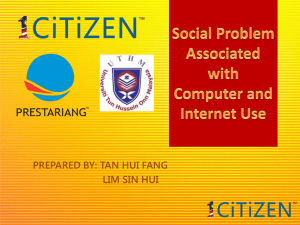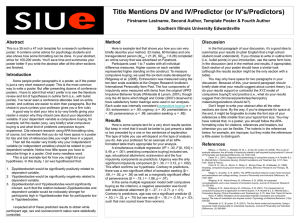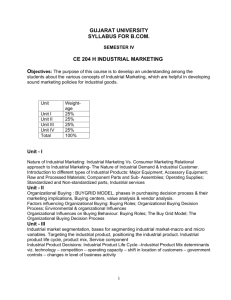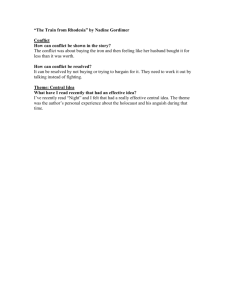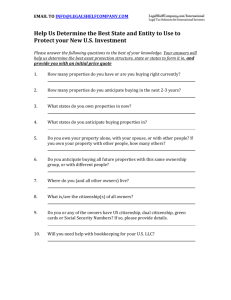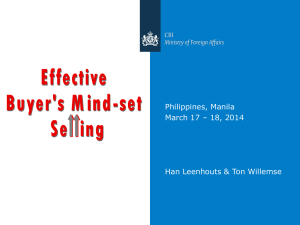Compulsive Buying Behavior Among Young Malaysian Consumers
advertisement
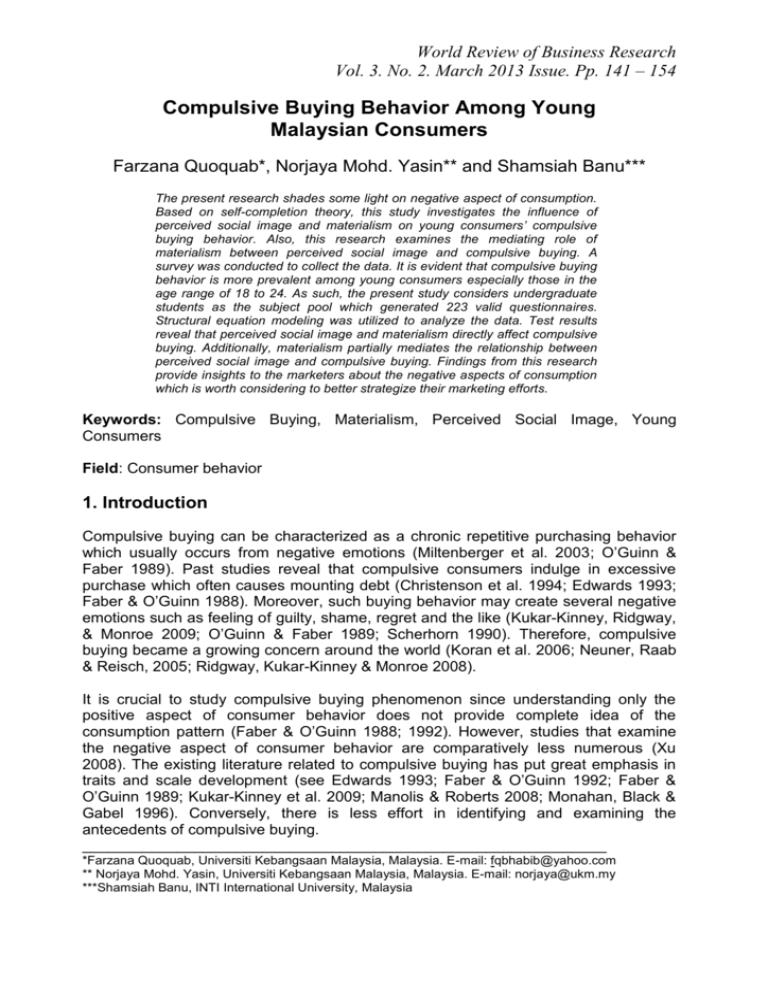
World Review of Business Research Vol. 3. No. 2. March 2013 Issue. Pp. 141 – 154 Compulsive Buying Behavior Among Young Malaysian Consumers Farzana Quoquab*, Norjaya Mohd. Yasin** and Shamsiah Banu*** The present research shades some light on negative aspect of consumption. Based on self-completion theory, this study investigates the influence of perceived social image and materialism on young consumers’ compulsive buying behavior. Also, this research examines the mediating role of materialism between perceived social image and compulsive buying. A survey was conducted to collect the data. It is evident that compulsive buying behavior is more prevalent among young consumers especially those in the age range of 18 to 24. As such, the present study considers undergraduate students as the subject pool which generated 223 valid questionnaires. Structural equation modeling was utilized to analyze the data. Test results reveal that perceived social image and materialism directly affect compulsive buying. Additionally, materialism partially mediates the relationship between perceived social image and compulsive buying. Findings from this research provide insights to the marketers about the negative aspects of consumption which is worth considering to better strategize their marketing efforts. Keywords: Compulsive Buying, Materialism, Perceived Social Image, Young Consumers Field: Consumer behavior 1. Introduction Compulsive buying can be characterized as a chronic repetitive purchasing behavior which usually occurs from negative emotions (Miltenberger et al. 2003; O’Guinn & Faber 1989). Past studies reveal that compulsive consumers indulge in excessive purchase which often causes mounting debt (Christenson et al. 1994; Edwards 1993; Faber & O’Guinn 1988). Moreover, such buying behavior may create several negative emotions such as feeling of guilty, shame, regret and the like (Kukar-Kinney, Ridgway, & Monroe 2009; O’Guinn & Faber 1989; Scherhorn 1990). Therefore, compulsive buying became a growing concern around the world (Koran et al. 2006; Neuner, Raab & Reisch, 2005; Ridgway, Kukar-Kinney & Monroe 2008). It is crucial to study compulsive buying phenomenon since understanding only the positive aspect of consumer behavior does not provide complete idea of the consumption pattern (Faber & O’Guinn 1988; 1992). However, studies that examine the negative aspect of consumer behavior are comparatively less numerous (Xu 2008). The existing literature related to compulsive buying has put great emphasis in traits and scale development (see Edwards 1993; Faber & O’Guinn 1992; Faber & O’Guinn 1989; Kukar-Kinney et al. 2009; Manolis & Roberts 2008; Monahan, Black & Gabel 1996). Conversely, there is less effort in identifying and examining the antecedents of compulsive buying. _____________________________________________________________ *Farzana Quoquab, Universiti Kebangsaan Malaysia, Malaysia. E-mail: fqbhabib@yahoo.com ** Norjaya Mohd. Yasin, Universiti Kebangsaan Malaysia, Malaysia. E-mail: norjaya@ukm.my ***Shamsiah Banu, INTI International University, Malaysia Quoquab, Yasin & Banu It is suggested that, individuals with high materialistic value prefer to acquire and to use more goods and services than others (Dittmar, Beattie & Friese 1996). Such materialistic individuals continue to purchase the products that may improve their selfdefinitions. Eventually, it results in chronic state of purchasing tendency. Additionally, some individuals are very conscious about their social image and thus, they tend to purchase excessive products and services that enhance their social image. As a whole, it is expected that perceived social image and materialism are two key predictors of compulsive buying. Past studies have examined the direct influence of perceived social image and materialism on compulsive buying and found support for these relationships (Jalees 2007; Xu 2008; Yurchisin & Johnson 2004). However, there is a dearth of research examining direct relationship between perceived social image and compulsive buying. Moreover, the mediating role of materialism between perceived social image and compulsive buying also yet to be tested. Thus, the present research is an effort to fill these gaps in the existing literature. Additionally, most of the past studies examined compulsive buying phenomenon predominantly in the apparel sector (see Elliot 1994; Jalees 2007; Park & Burns 2005; Roberts 1998; Yurchisin & Johnson 2004). This led the motivation for the present research to study compulsive buying in the ‘in-store’ shopping context. The objective of this study is to enhance the knowledge about compulsive buying in the retail consumption environment. More specifically, the present study aims to (i) investigate the relationships among perceived social image, materialism and compulsive buying among Malaysian young consumers, and (ii) to examine the mediating effect of materialism between perceived social-image and consumers’ compulsive buying. In the next section, some relevant literatures are reviewed to hypothesize the proposed relationships. Then, a brief discussion of methodology, analysis and findings are presented followed by conclusion. Lastly, implications are discussed, limitations are acknowledged and future research directions are stated. 2. Literature Review and Development of Hypotheses Compulsive Buying Compulsive buying is a dysfunctional behavior (Dittmar 2005) which causes serious psychological harm and often leads to substantial debt (e.g. Benson 2000; Dittmar 2004). Different authors have defined this phenomenon in different ways (see the Table 1). Perhaps, the most cited definition is given by O’Guinn and Faber (1989, p.155), i.e., compulsive buying “is a chronic, repetitive purchasing behavior that becomes a primary response to negative events or feelings”. Usually, compulsive buyers consider shopping as a way to escape from their emotional sufferings such as anxiety, fears, mental agony, frustration, pains and stress (Faber, O’Guinn & Reymond 1987; Jalees 2007; Neuner et al. 2005). Additionally, enhancing self-esteem and social status also motivate some individuals to consume excessively (Xu 2008; Yurchisin & Johnson 2004). 142 Quoquab, Yasin & Banu Table 1: Conceptualization of Compulsive Buying Construct in Past Selected Studies Author and year Faber et al. (1987) Definitions CB is a “type of consumer behavior which is inappropriate, typically excessive, and clearly disruptive to the lives of individuals who appear impulsively driven to consumer” (p.132). McElroy et al. (1994) CB is an uncontrollable, distressing, time consuming shopping behavior that produces financial difficulties. Dittmar and Drury (2000) CB is a “deviant activity, qualitatively distinct from ordinary consumer behaviour, and in common with the other models it cannot explain why only certain goods are bought impulsively and excessively” (p.112). Miltenberger et al. (2003) CB “occurs in response to negative emotions and results in a decrease in the intensity of the negative emotions” (p.1). Dittmar (2004) The impulse to buy is experienced as irresistible, individuals lose control over their buying behaviour, and they continue with excessive buying despite adverse consequences in their personal, social, or occupational lives, and financial debt. Jalees (2007) CB is a spending addiction in which “one devotes or surrenders oneself to something habitually or obsessively, behavior that impairs and effects the performance of a vital function, a harmful development” (p.31). Mittal et al. (2008) It is a chronic tendency to purchase products far in excess of a person’s needs and resources. Ridgway et al. (2008) CB refers to a consumers’ tendency to be preoccupied with buying that is revealed through repetitive buying and a lack of impulse control over buying. Billieux et al. (2008) CB is uncontrolled and excessive purchases leading to personal and family distress. Note: CB refers to compulsive buying Perceived Social Image Perceived social-image is described as “a person’s perceptions about being superior and rich in a social setting. It indicates standards of living perceived by the people” (Jalees 2007, p.34). The people who are highly conscious about their perceived social image consciously try to impress others (d’Astous 1990). They tend to be very careful in conveying the impression of themselves in front of others as a social object (Carver & Scheier 1985; Tobey & Tunnell 1981). This continuous self-consciousness drives them to purchase the symbolic goods and services that may enhance their social image (d’Astous 1990). Materialism Typically, materialism denotes consumer’s propensity to be attached with the worldly possessions (Belk 1984). It is found that, individuals with high materialistic value engage in worldly possessions in order to attain need gratification (Belk 1983) and to 143 Quoquab, Yasin & Banu improve the concept of their own self (Dittmar 2005). Therefore, such individuals indulge in purchasing excess goods and services and are often failed to realize that they already possessed sufficient materials (Dittmar et al. 1996). In this way, materialism positively affects compulsive buying. Perceived Social Image, Materialism and Compulsive Buying The symbolic self-completion theory advocates that individuals hold their own self definition and if they perceive any discrepancy between their ‘actual-self’ and the ‘desired-self’, they feel urge to improve their self definition (Wicklund & Gollwitzer 1982). Past research suggests that discrepancy in self definition may positively affect compulsive buying (Yurchisin & Johnson 2004). This is due to the fact that, to compensate such discrepancy, individuals often engage in purchasing such products and services that help improving their ‘actual-self’. In support of this view, past studies found that, compulsive buyers are motivated by the status-enhancing aspects of buying (Krugger 1998; O’Guinn & Faber 1989). In this instance, some individuals do not stop purchasing product rather they engage in buying more which consequently leads to compulsive buying. D’Astous and Tremblay (1989) also found support for this view. According to them, compulsive buyers tend to possess the goods and services that are related to social acceptance and status. Moreover, in examining compulsive consumption among US college students, Roberts (1998) found that social status is associated with compulsive buying. Therefore, it is hypothesized that: H1: Perceived social image has a significant positive influence on compulsive buying. As mentioned above, theory of symbolic self-completion put forward the idea that the discrepancy between ‘actual-self’ and ‘desired-self’ drives individuals in purchasing more goods and services as the means to enhance their present self state. In this regard, materialism acts as a compensation strategy (Dittmar & Drury 2000) and contributes in compulsive buying (Yurchisin & Johnson 2004). Faber and O’Guinn’s (1988) empirical study also echoed this idea. In addition to this, Richins and Dawson (1992) contended that materialism results from dissatisfaction of one’s-self and is negatively related to self-esteem. Whereas, Wong (1997) found that materialism is positively related to public self-consciousness. In a similar vein, Tunnel (1984) stated that the individuals who have low self-esteem are more likely to be high in materialism. On the basis of these discussions, the following hypotheses are developed: H2: Perceived social image has a significant positive influence on materialism. H3: Materialism has a significantly positive influence on compulsive buying. H4: Materialism mediates the relationship between perceived social image and compulsive buying. Conceptual Model Proposed relationships among the study variables are shown in the Figure 1. 144 Quoquab, Yasin & Banu H1 Perceived Social Image Compulsive Buying Behavior H2 H4: Perceived Social Image Materialism Materialism H3 Compulsive Buying Figure 1: Proposed Relationships among the Study Variables 3. Methodology Measures The present study utilized established multi-item scales to measure the study constructs. The scale to measure compulsive buying was borrowed from Faber and O’Guinn (1992) and materialism scale was borrowed from Jalees (2007). Perceived social image was measured using the scale borrowed from Elliot (1994). All the study constructs were measured using five-point Likert scale ranged from 1=strongly disagree to 5=strongly agree. The full set of questionnaire is shown in the Appendix. Sample and Sampling Strategy It is evident that compulsive buying behavior generally occurs at late adolescence or in early adulthood (Christenson et al. 1994; Schlosser et al., 1994; Yurchisin & Johnson 2004). To capture this particular age group, often researchers target the undergraduate students as the subject pool (see Edwards 1993; Roberts 1998; Yurchisin et al. 2004). Following this convention, the present research also considered undergraduate students as respondents. According to Calder et al. (1981) and Diamantopoulous and Schlegelmilch (1997), non-probability sampling is applicable when the objective of the study is to obtain theoretical generalizability rather than to achieve population generalizability. Since, the present research aims to attain theoretical generalizability by comprehending the existing knowledge in the field of consumer behavior by examining the negative aspect of consumption, the use of convenience sampling (a non-probability sampling method) is justified. Data were collected from a reputable private university in Malaysia using self-administered questionnaire survey. In total, 300 questionnaires were distributed and 236 questionnaires were collected. After sorting and cleaning the data, 223 usable questionnaires were obtained to run the analyses. Structural equation modeling (SEM) using AMOS18 maximum likelihood estimation was utilized to analyze the data. To run SEM, the general rule of thumb is that the sample size is needed to be greater than or equal to 200 (Kline 2005). Therefore, for this study, the sample size of 223 was deemed sufficient to run SEM. 145 Quoquab, Yasin & Banu Among 223 respondents, 94 were female and 129 were male. Majority of the respondents’ age was ranged from 18 to 22 and the rest were between 23 to 27 years old. 98.2 % respondents were single and only 1.8% were married. In terms of ethnicity, 74% were Chinese, 11.7% were Malays, 9% were foreigners and the rest were Indians. With regard to monthly disposable income, 86% respondents mentioned that their monthly disposable income (or pocket money) falls between RM500 to RM1000 and the rest had more than RM1000 disposable income. 4. Results and Discussions Descriptive Statistics and Correlations Table 2 shows the means, standard deviations, zero-order correlations, and Cronbach’s alpha coefficients of the study variables. Table 2: Results of Variables’ Means, Standard Deviations, Zero-Order Correlations, and Cronbach’s Alpha Coefficients M SD Variable 1 2 3 1. Compulsive Buying 2.041 0.635 (0.704) ** 2. Materialism 3.366 0.767 0.248 (0.706) ** ** 3. Perceived social image 3.667 0.874 0.507 0.313 (0.864) Note: N = 223. Cronbach alphas are in parentheses on the diagonal. **correlation is significant at the 0.01 level (2 tailed). Confirmatory Factor Analysis The present study has followed Anderson and Gerbing’s (1988) two steps approach. In the first stage, CFA was run for the overall measurement model. The result produced adequate goodness of fit indices of the measurement model with χ2/df = 1.598; GFI = 0.910; TLI = 0.936; CFI = 0.947; IFI = 0.948; and RMSEA = 0.052. In the next stage, convergent and discriminant validity were established and mediation test was performed. Finally the full structural model was tested. Convergent and Discriminant Validity All items were loaded significantly with their related constructs and ranged from 0.504 to 0.939. Composite reliability for each construct was above the recommended cut off value of 0.7 and ranged from 0.770 to 0.866 (guided by Hair et al. 2006). Average variance extracted (AVE) result also was satisfactory and ranged from 0.506 to 0.620 which exceeded the recommended threshold level of 0.5 (Hair et al. 2006). All these tests results assured the convergent validity (see Table 3). Table 3: Test Results of Composite Reliability and AVE Constructs Compulsive buying Perceived social image Materialism Composite Reliability 0.858 0.868 0.770 Average Variance Extracted 0. 506 0.620 0.534 146 Quoquab, Yasin & Banu Discriminant validity was assessed by comparing the fit of the unconstrained measurement model to alternative models in which two latent constructs were constrained at a time by setting their correlations equal to one (Bagozzi & Phillips 1982; Lavelle et al. 2009). In each case, the chi-square difference test was found significant which indicated that the measurement model fits the data better than all other alternative models. Thus, discriminant validity was established. Tests of Hypotheses In testing the hypothesized mediating relationship, a mediation test was performed. First, the conditions of mediation were assessed (Aryee & Chen 2006; Prussia & Kinicki 1996). Correlation coefficients indicated that perceived social image was significantly correlated with the dependent variable (compulsive buying), as well as with the mediator variable (materialism) (see Table 2). In addition, materialism was significantly correlated with compulsive buying. Thus, the first three conditions were fulfilled. To evaluate the fourth condition for mediation, the fit of the alternative models to the hypothesized mediation model was compared. The findings suggest the appropriateness of the partially mediated model (see Table 4). The chi-square difference test results indicate a significant improvement of fit of the partially mediated model (∆χ2 = 47.348, p<0.001). The partially-mediated model also indicates a significant improvement on the non-mediated model (∆ χ2 = 9.097, p<0.001). Thus, the hypothesized partially mediated model was a better fit with χ 2/df = 1.769; GFI = 0.928; TLI = 0.923; CFI = 0.939; IFI = 0.940; and RMSEA = 0.059. Hence, H4 is supported. Table 4: Results of Model Comparison for the Mediated Model Model χ2 df 1. Full Mediation Model 2. Partial Mediation Model 3. Nonmediation Model Difference (model 1-2) Difference (model 3-2) 157.034 ∆ χ2 ∆df GFI CFI TLI IFI 63 .905 .880 .851 .882 .082 109.686 62 .928 .939 .923 .940 .059 118.783 63 .922 .929 .912 .930 .063 47.348* 1 9.097* 1 RMSEA Next, the overall structural model was assessed to test hypothesized direct relationships. Figure 2 displays structural coefficients for the full model which suggests that perceived social image significantly affects compulsive buying as well as materialism (H1: β=0.568, p<0.001; H2: β=0.192, p<0.05). It is also found that materialism directly and positively affects compulsive buying (H3: β=0.226, p<0.001). Furthermore, the mediation test results reveal that materialism exerts indirect effect on compulsive buying (H4) (see the mediation test results in Table 4). For the full structural model, the overall evaluation of the fit indices show acceptable model fit with χ2/df = 1.71; GFI = 0.903; TLI = 0.924; CFI = 0.936; IFI = 0.937; and RMSEA = 0.057. 147 Quoquab, Yasin & Banu 0.568** Compulsive Buying Perceived Social Image 0.192* 0.226** Materialism χ2/df = 1.71; GFI = 0.903; TLI = 0.924; CFI = 0.936; IFI = 0.937; and RMSEA = 0.057 Note: **p<0.001, *p<0.05 Figure 2: Structural Equation Model Representing the Relationships among the Variables 5. Conclusion Grounded on symbolic self-completion theory, the present study examines the influence of perceived social image and materialism on young consumers’ compulsive buying behavior. This study has significance in terms of exploring the relationship between ‘perceived social image’ and ‘materialism’ and the mediating role of materialism between ‘perceived social image’ and ‘compulsive buying’, which have not gain the attention of past researchers. Findings from this study suggest that, perceived social image strongly affect compulsive buying. This finding supports the notion of symbolic self-completion theory. More clearly, individuals with a greater concern about their social image are more sensitive to the discrepancy between their ‘actual-self’ and ‘desired-self’. And thus, they tend to purchase more products and services that may enhance their social status in front of others which eventually leads to compulsive buying behavior. This finding is in line with past studies (see Elliot 1994; Yurchisin & Johnson (2004). Additionally, Elliot (1994) and Yurchisin and Johnson (2004) contended that, in the context of apparel industry, perceived social image is linked to addictive consumption tendencies. Data from this study suggest that perceived social image directly, positively and significantly affect materialism. This is comparatively a new link that the present research verifies. This finding put forward the idea that, individuals with high selfawareness tend to value materialism as the way to improve their social status. In other words, consumers who are highly conscious about their social image are inclined to acquire more goods and services to enhance their actual self. If not the same, but in a similar stream of research examining the relationship between public selfconsciousness and materialism, Wong (1997) found support for this link. On the other hand, Xu (2008) found partial support where public self-consciousness was significantly related to acquisition of centrality but not with possession defined success and pursuit of happiness. 148 Quoquab, Yasin & Banu Similar to perceived social image, materialism also significantly and positively affect compulsive buying. Past studies support this notion (Dittmar 2005; Roberts 2000; Xu 2008). It explains the fact that, young consumers consider compulsive buying as a symbolic self-completion strategy in which they try to enhance the discrepancy between actual and desired self by engaging in excessive purchases. Last but not least, the findings of the present study reveals that, materialism partially mediates the relationship between perceived social image and compulsive buying. In other words, young consumers who are very conscious about their perceived social image are prone to high materialistic value. Consequently, they heavily engage in compulsive buying. 6. Implications, Limitations and Future Research Directions It is suggested that, materialism is neither a positive trait, nor a negative trait (Csikszentmihalyi & Rochber-Halton 1978). However, often materialism is accompanied by some negative traits such as greediness, jealousy or miserliness which can create mental problem rather than happiness (Belk 1985). Moreover, too much indulgence in materialism may generate addiction in consumption which certainly poses mental, financial and social threat to the consumers. Findings from this study contend that, perceived social image directly as well as indirectly affect compulsive buying. Since, excess self awareness may be pathological and can drive individuals to uncontrolled purchase, clinical help can be sought to cure this problem. Moreover, to prevent compulsive buying, initiatives can be taken from both government and social marketers’ side to disseminate sufficient information to consumers to make them aware about the causes and its harmful consequences. It can be done through advertisement as well as by incorporating and highlighting this issue in the school curricula by addressing what are the consequences of excessive consumption and to avoid the uncontrolled shopping and spending. Financial institutions such as banks must also impose certain restrictions in issuing credit cards to the young consumers to avoid the excessive usage of credit cards in their purchases. Furthermore, it is also necessary for the marketers to provide sufficient information to their consumers regarding both positive and negative aspects of materialism which is the prime facet of consumerism. This study contributes theoretically as well as practically in the existing knowledge pertaining to consumer compulsive behavior. However, this study is not without limitations. The present research has considered university students as the subject pool. Future study may collect data through shopping mall intercept capturing the young working population to verify these relationships to obtain greater generalizability of the findings. Furthermore, since the existing literature examining compulsive buying are predominantly based on purchases of goods, future research is suggested to study this negative consumption behavior in the context of service consumption. 149 Quoquab, Yasin & Banu References Anderson, JC & Gerbing, W 1988, Structural equation modeling in practice: A review and recommended two-step approach’, Psychological Bulletin, vol. 103, no. 3, pp. 411-423. Aryee, S & Chen, ZX 2006, ‘Leader-member exchange in a Chinese context: antecedents, outcomes and mediating role of psychological empowerment, Journal of Business Research, vol. 59, no. 7, pp. 793-801. Bearden, WO & Netemeyer, RG 1999, Handbook of marketing scales: Multi-item measures for marketing and consumer behavior research, Sage Publications, Thousand Oaks, CA. Belk, RW 1983, ‘Worldly possessions: issues and criticisms’, Advances in Consumer Research, vol. 10, pp. 514-519. Belk, RW 1984, ‘Three scales to measure constructs related to materialism: Reliability, validity, and relationships to measures of happiness’, Advances in Consumer Research, vol. 11, pp. 291-297. Belk, RW 1985, ‘Materialism: trait aspects of living in the material world’, Journal of Consumer Research, vol. 12, pp. 265-280. Belk, RW & Pollay 1985. Images of ourselves: The good life in twentieth century advertising, Journal of Consumer Research, vol. 11, pp. 887-897. Benson, A 2000, I shop therefore I am: Compulsive buying and the search for self, Aronson New York. Billieux, J, Rochat L., Rebetez, MML & Van der Linden, M 2008, ‘Are all facets of impulsivity related to self-reported compulsive buying behavior?’, Personality and Individual Differences, vol. 44, pp. 1432–1442. Calder, BJ, Phillips, LW & Tybout, AM 1981, ‘Designing research for application’, Journal of Consumer Research, vol. 8, pp. 197-207. Carver, CS & Scheier, MF 1981, Attention and self-regulation: A control theory approach to human behavior, Springer-Verlag, New York. Christenson, GA, Faber, RJ, deZwaan, M, Raymond, NC, Secker, SM, Ekern, MD, Mackenzie, TB, Crosby, RD, Crow, SJ, Eckert, ED, Mussell, MP & Mitchell, JE 1994, ‘Compulsive buying: descriptive characteristics and psychiatric comorbidity’, Journal of Clinical Psychiatry, vol. 55, no. 1, pp. 5-11. Csikszentmihalyi, M & Rochber-Halton, E 1978, ‘Reflections on materialism’, University of Chicago Magazine, vol. 70, no. 3, pp. 6-15. D’Astous, A 1990, ‘An Inquiry into the Compulsive Side of 'Normal' Consumers’, Journal of Consumer Policy; vol. 13, no. 1, pp. 15-31. D'Astous, A & Tremblay, S 1989, ‘Compulsive buying tendencies of adolescent consumers’, Advances in Consumer Research, vol. 17, pp. 306-312. Diamantopoulos, A & Schlegelmilch, BB 1997, Taking the fear out of data analysis, Dryden, London. Dittmar, H, Beattie, J & Friese, S 1996, ‘Objects decision considerations and selfimage in men’s and Women’s impulse purchases’, Acta Psychologica, vol. 93, pp. 187-206. Dittmar, H 2004, ‘Understanding and diagnosing compulsive buying’, in R Coombs (ed.), Handbook of addictive disorders: A practical guide to diagnosis and treatment, Wiley, New York, pp. 411-450. Dittmar, H 2005, ‘Compulsive buying – a growing concern? An examination of gender, age, and endorsement of materialistic values as predictors, British Journal of Psychology, vol. 96, pp. 467–491. 150 Quoquab, Yasin & Banu Dittmar, H & Drury, J 2000, ‘Self–image—is it in the bag? A qualitative comparison between “ordinary” and “excessive” consumers’, Journal of Economic Psychology, vol. 21, pp. 109–142. Edwards, EA 1993, ‘Development of a new scale for measuring compulsive buying behavior’, Financial Counseling and Planning, vol. 4, pp. 67–84. Elliott, R 1994, ‘Addictive consumption: function and fragmentation in postmodernity’, Journal of Consumer Policy, vol. 17, no. 2, pp. 159-179. Faber, RJ & O'Guinn, TC 1988, ‘Expanding the view of consumer socialization: a nonutilitarian mass-mediated perspective’, in CE Hirschman & JN Sheth (ed.), Research in Consumer Behavior, vol. 3, Greenwich, CT: JAI, pp. 49-77. Faber, RJ & O'Guinn, TC 1989, ‘Classifying compulsive consumers: advances in the development of a diagnostic tool’, Advances in Consumer Research, vol. 16, pp. 738-744. Faber, RJ and O'Guinn, TC 1992, ‘A clinical screener for compulsive buying’, Journal of Consumer Research, vol. 19, pp. 459-469. Faber, R, O’Guinn, T and Reymond, S 1987, ‘Compulsive consumption’, Advanced in Consumer Research, vol. 14, no. 1, pp. 132-5. Fah, BCY, Foon, YS & Osman, S 2011, ‘An exploratory study of the relationships between advertising appeals, spending tendency, perceived social status and materialism on perfume purchasing behavior’, International Journal of Business and Social Science, vol. 2, no. 10, pp. 202-208. Fenigstein, A, Scheier, MF & Buss, AH 1975, ‘Public and private self-consciousness: assessment and theory’, Journal of Consulting and Clinical Psychology, vol. 43, no. 4, pp. 522-527. Goldberg, ME, Gorn, GJ, Peracchio, LA & Bamossy, G 2003, ‘Understanding materialism among youth’, Journal of Consumer Psychology, vol. 13, no. 3, pp. 278–288. Hair, JF Jr, Black, WC, Babin, BJ, Anderson, RE & Tatham, RL 2006, Multivariate data analysis, 6th edn, Prentice – Hall, International Inc, Upper Saddle River, New Jersey, USA. Higgins, T 1987, ‘Self-discrepancy: A theory relating self to affect’, Psychological Review, vol. 94, pp. 319-340. Jalees, T 2007, ‘Identifying determinants of compulsive buying behavior’, Market forces, vol. 3, no. 2, pp. 30-51. Koran, L, Faber, RJ, Aboujaoude, E, Large, MD & Serpe, RT 2006, ‘Estimated prevalence of compulsive buying behavior in the United States’, American Journal of Psychiatry, vol. 163, no. 1, pp. 1806–1812. Krugger, D 1998. ‘On compulsive shopping and spending: a psychodynamic inquiry’, American Journal of Psychotherapy, vol. 42, no. 4, pp. 574-84. Kukar-Kinney, M, Ridgway, NM & Monroe, KB 2009, ‘The relationship between consumers’ tendencies to buy compulsively and their motivations to shop and buy on the internet’, Journal of Retailing, vol. 85, no. 3, pp. 298–307. Lavelle, JJ, Brockner, J, Konovsky, MA, Price, K, Henley, A, Taneja, A & Vinekar, V 2009, ‘Commitment, procedural fairness, and organizational citizenship behavior: a multifoci analysis’, Journal of Organizational Behavior, vol. 30, pp. 337-357. Manolis, C & Roberts, JA 2008, ‘Compulsive buying: does it matter how it’s measured?’, Journal of Economic Psychology, vol. 29, pp. 555–576. McAlister, L & Pessemier, E 1982, ‘Variety-seeking behavior: an interdisciplinary review’, Journal of Consumer Research, vol. 9, no. 3, pp. 311–22. 151 Quoquab, Yasin & Banu McElroy, SL, Keck, PE, Pope, HG, Smith, MJ & Strakowski, SM 1994, ‘Compulsive Buying:AReport of 20 Cases’, Journal of Clinical Psychiatry, vol. 55, pp. 242– 248. Miltenberger, RG, Redlin, J, Crosbyb, R, Stickney, M, Mitchell, J, Wonderlich, S, Faber, R, & Smyth, J 2003, ‘Direct and retrospective assessment of factors contributing to compulsive buying’, Journal of Behavior Therapy and Experimental Psychiatry, vol. 34, pp. 1–9. Mittal, B, Holbrook, MB, Beatty, S, Raghubir, P & Woodside, AG 2008, Consumer behavior: how humans think, feel, and act in the marketplace, Open Mentis Publishing Company, Cincinnati, OH. Monahan, P, Black, DW & Gabel, J 1996, ‘Reliability and validity of a scale to measure change in persons with compulsive buying’, Psychiatry Research, vol. 64, pp. 5967. Neuner, M, Raab, G & Reisch, LA 2005, ‘Compulsive buying in maturing consumer societies: An empirical re-inquiry’, Journal of Economic Psychology, vol. 26, pp. 509–522 O’Guinn, TC & Faber, RJ 1989, ‘Compulsive buying: a phenomenological exploration’, Journal of Consumer Research, vol. 16, pp. 147–157. Prussia, GE & Kinicki, AJ 1996, ‘A motivational investigation of group effectiveness using social cognitive theory’, Journal of Applied Psychology, vol. 81, pp. 187198. Park, HJ & Burns, LD 2005, ‘Fashion orientation, credit card use, and compulsive buying’, Journal of Consumer Marketing, vol. 22, no. 3, pp. 135–141. Richins, M 1994, ‘Special possessions and the expression of material value’, Journal of Consumer Research, vol. 21, no. 3, pp. 522-33. Richins, M 2004, ‘The material values scale: Measurement properties and development of a short form’, Journal of Consumer Research, vol. 31, pp. 209– 219. Richins, ML & Dawson, S 1992, ‘A consumer values orientation for materialism and its measurement: scale development and validation’, Journal of Consumer Research, vol. 19, no. 3, pp. 303-16. Ridgway, NM, Kukar-Kinney, M & Monroe, KB 2008, ‘An expanded conceptualization and a new measure of compulsive buying’, Journal of Consumer Research, vol. 35, no. 4, pp. 622–39. Rindfleisch, A, Burroughs, J & Denton, F 1997, ‘Family structure, materialism, and compulsive consumption’, Journal of Consumer Research, vol. 23, no. 4, pp. 312-25. Rindfleisch, A, Burroughs, JE & Denton, F 1997, ‘Family structure, materialism, and compulsive consumption’, Journal of Consumer Research, vol. 23, pp. 312-325. Roberts, J 1998, ‘Compulsive buying among college students: an investigation of its antecedents, consequences, and implications for public policy’, Journal of Consumer Affairs, vol. 32, no. 2, pp. 295-319. Roberts, J 2000, ‘Consuming in a consumer culture: college student, materialism, status consumption, and compulsive buying;, Marketing Management Journal, vol. 10, no. 2, pp. 76-91. Scherhorn, G 1990, ‘The addictive trait in buying behavior’, Journal of Consumer Policy, vol. 13, no. 1, pp. 33–51. Schlosser, S, Black, DW, Repertinger, S & Freet, D 1994 ‘Compulsive buying: Demography, phenomenology, and comorbidity in 46 subjects’, General Hospital Psychiatry, vol. 16, pp. 205-212. 152 Quoquab, Yasin & Banu Shiffman, L & Kanuk, L 2000, Consumer Behavior, 7th edn, Prentice-Hall, Upper Saddle River, NJ. Shoham, A & Brencic, MM 2003, ‘Compulsive buying behavior’, Journal of Consumer Marketing, vol. 20, no. 2, pp. 127-138. Tobey, EL & Tunnell, G 1981, ‘Predicting our impressions on others: Effects of public self-consciousness and acting, a self-monitoring subscale’, Personality and Social Psychology Bulletin, vol. 1, pp. 661-669. Tunnell, G 1984, ‘The discrepancy between private and public selves: public selfconsciousness and its correlates’, Journal of Personality Assessment, vol. 48, no. 5, pp. 549-55. Ullman, LP & Krasner, L 1969, A Psychological Approach to Abnormal Behovior, Prentice Hall, Englewood Cliffs. Valence, G, D’Astous, A & Fortier, L 1988, ‘Compulsive buying: concept and measurement’, Journal of Consumer Policy, vol. 11, no. 4, pp. 419-433. Wicklund, RA & Gollwitzer, PM 1981, ‘Symbolic self-completion, attempted influence, and self-deprecation’, Basic and Applied Social Psychology, vol. 2, no. 2, pp. 89114. Wicklund, RA & Gollwitzer, PM 1982, Symbolic self-completion, Lawrence Erlbaum Associates, Hillsdale, NJ. Wong, N 1997, ‘Suppose you own the world and no one knows? Conspicuous consumption, materialism and self’, Advances in Consumer Research, vol. 24, no. 1, pp. 197-203. Xu, Y 2008, ‘The influence of public self-consciousness and materialism on young consumers’ compulsive buying’, Young Consumers, vol. 9, no. 1, pp. 37-48. Yurchisin, J & Johnson, KKP 2004, ‘Compulsive buying behavior and its relationship to perceived social status associated with buying, materialism, self-esteem, and apparel-product involvement’, Family and Consumer Sciences Research Journal, vol. 32, no. 3, pp. 291-314. 153 Quoquab, Yasin & Banu Appendix Full set of questionnaire used in this study CB2 CB3 CB4 CB5 CB6 CB7 Factors/ Items Compulsive buying I have bought something and when I got home I wasn’t sure why I had bought it. I Just wanted to buy things and didn’t care what I bought. I have bought things even though I couldn’t afford them. I wrote a cheque when I didn’t have enough money in the bank to cover it. If I have money left at the end of the day period, I just have to spend it. I felt anxious or nervous on days I didn’t go shopping. I have bought something in order to make myself feel better. PSI8 PSI9 PSI10 PSI11 PSI12 Perceived social image I feel more important when I am buying things. My purchases make me feel as good as anyone else. When my friends and colleagues buy things, I tend to imitate them. I like to impress people with my purchases. I frequently buy things just because they look nice on other people. CB1 Materialism MAT13 It is important to me to have really nice things. MAT14 I would like to be rich enough to buy anything I want. MAT15 I would be happier if I could afford to buy more things. 154
